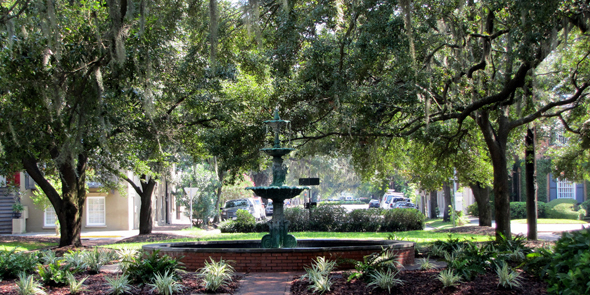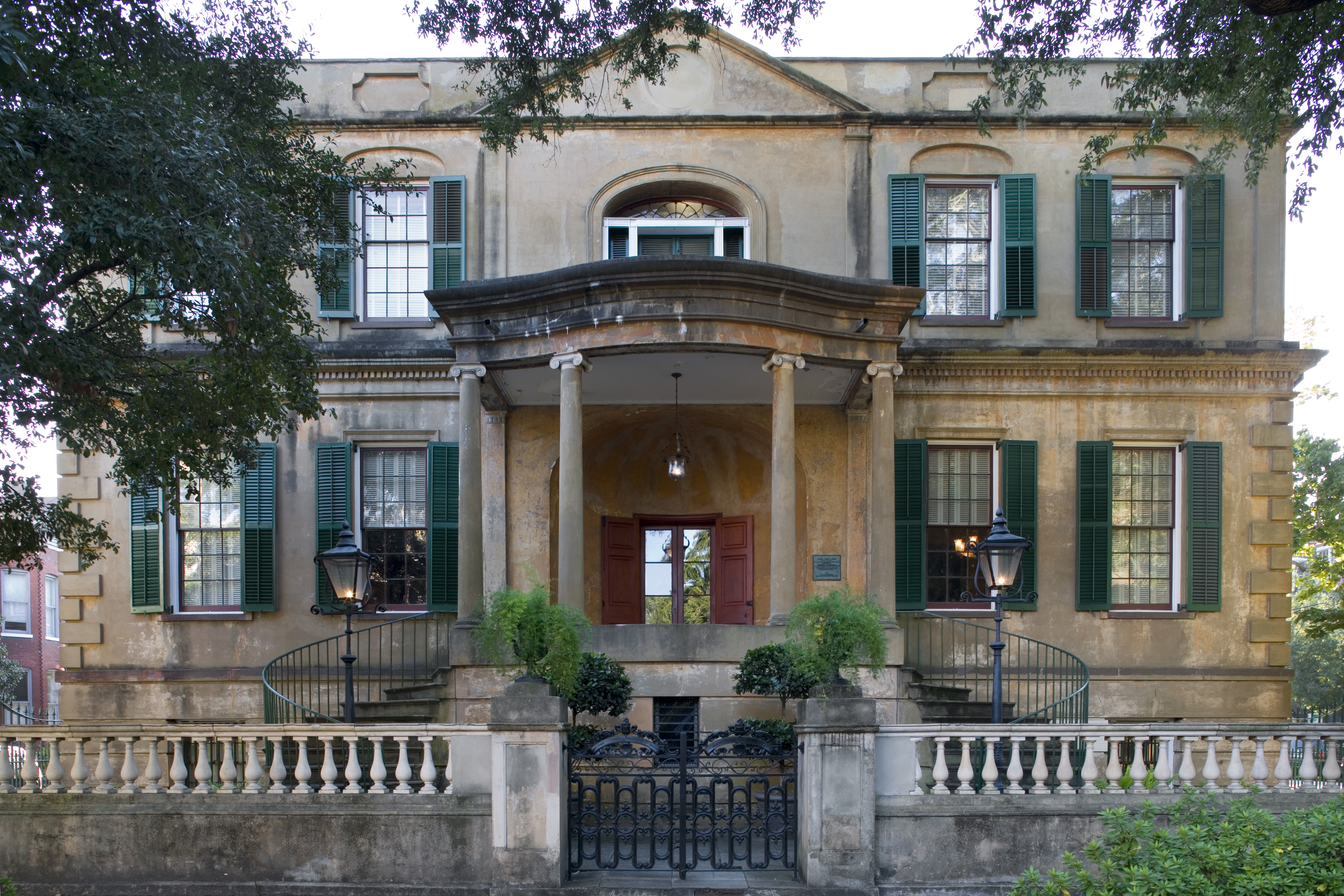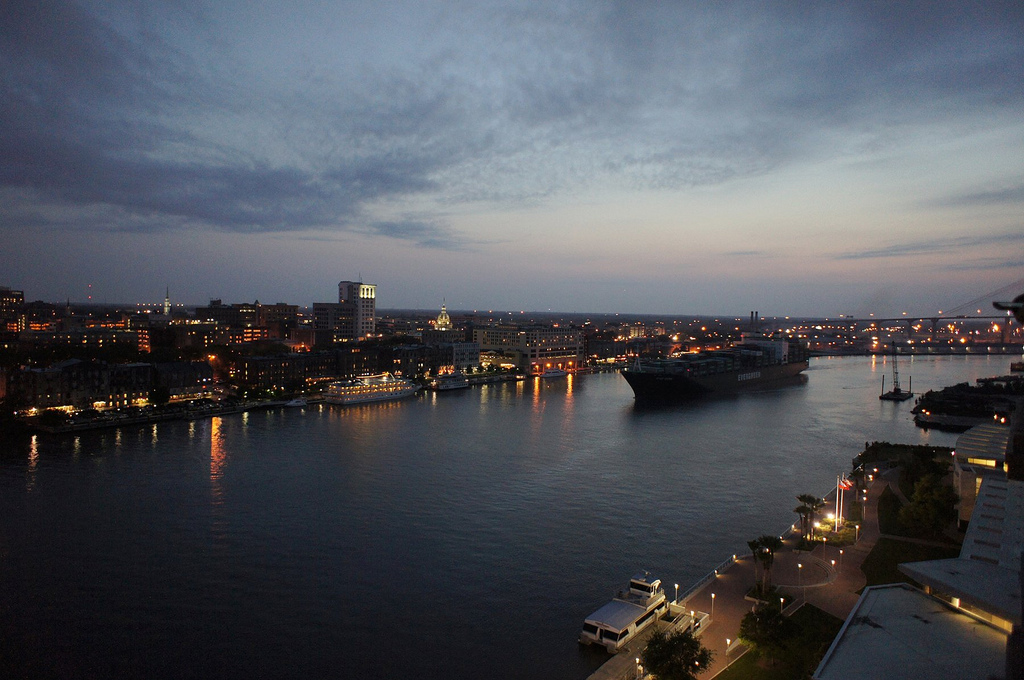For anyone craving some old-fashioned southern gentility Savannah’s Historic District is the perfect place to find it.

One of the historic district’s exquisite squares.| Photo Paul Hamilton via Flickr
Its manicured squares and elegant mansion houses are as inviting as that homely southern accent, a voice described in Gone With the Wind as “soft and slurring, liquid of vowels, kind to consonants.”
Nestled between golden marshland and the Atlantic, Savannah is one of the oldest cities in the South. The elegant squares of its famous historic district were laid down in the 1730s according to a plan by James Oglethorpe, the founder of Georgia.
An Englishman infused with the ideas of the enlightenment, Oglethorpe envisioned a series of wards each composed of eight blocks surrounding a central square. While Oglethorpe only laid out four of these wards himself, the town planners repeated the design again and again down the centuries so that 24 wards now exist within the city limits.
Many of the squares beguile in their beauty, decked with oaks and magnolias, fountains and sculptures. Surrounding the squares you’ll find splendid colonial townhouses.
One of these is Davenport House, which was named after its original owner, Isiah Davenport, a carpenter who moved to Savannah from New England in the 1820s. The house has been restored to look as it would have in the era Davenport built it.
As well as being an important historical document, the house is also a poster child for the conservation movement in America, since the effort to save it from demolition by a group of committed local women in the 1950s was the catalyst for the preservation of many other homes in the historic district, which until then had been left to rot.
Another beautifully preserved town house is the Owens-Thomas House located in Oglethorpe square, which was named in honor of the city’s founding father. Built around the same time as Davenport House, it is widely considered one of the best examples of Regency architecture in America. Home to generations of Savannah aristocracy the house is now a museum filled with art and furnishings from the eighteenth and nineteenth century. As well as a parterre garden, the site also includes a carriage house with an intact slave quarters.

The Owens-Thomas House in Oglethorpe Square.| Photo by Attic Fire Courtesy of Telfair Museums
Walking around the beautiful mansions of the historic district it’s easy to forget that all this luxury came at a price. The ones who paid that price were the countless Africans sold into slavery and their children, who were born and raised to work on the plantations that littered the countryside hereabouts. While the Oglethorpe plan was based around ideas of social equity Savannah was an important port in the slave trade.
You can educate yourself about this at the Ralph Mark Gilbert Civil Rights Museum, also in the historic district. The museum, which is housed in a former savings and loans bank that catered exclusively to blacks, is named after the father of Savannah’s modern civil rights movement and using historic photographs and interactive guides chronicles the civil rights struggle of Georgia’s oldest African-American community from slavery to the present.
Despite there being an African-American in the White House, the legacy of slavery and the prejudices it encouraged have not quite been purged from the South.
The most notable recent example of this was Paula Deen. Playing on her down-home southern charm Deen had built up a lucrative career as a TV chef and, by the time of her fall from grace last year, the Savannah resident was a household name in the US. Deen’s career was derailed after staff at her Savannah restaurant accused the celebrity chef of racism. Despite a tearful public apology Deen was dropped by several TV channels and lost numerous endorsements.
Revealingly, at the same time Deen was being dragged over the coals dozens were turning up outside of her Savannah eaterie. Not to protest against her, but to offer their support.
Flannery O’Connor wrote searingly about the bigotry of white people in the South. She was born in the city but lived most of her life in rural Georgia. Stricken with lupus she died tragically young, but not before she had left a series of mesmerizing novels and short stories that fizz with righteous indignation and a darkly comic vision of rural life.
She was a committed Catholic with a deeply satirical streak and her take on life is nicely encapsulated in a quote from one of her letters:
“I don’t deserve any credit for turning the other cheek as my tongue is always in it.”
The house where O’Connor was born is in the historic district and is now a museum. It has been restored to how it would have looked at the time of the Depression when O’Connor lived here with her family. O’Connor’s harsh – though ultimately loving – critique of Southern society make her a divisive figure for some.
A more obvious favorite son of Savannah was the songwriter Johnny Mercer. If you don’t know who Mercer was then any trip to Savannah is likely to bring you into contact with his most famous song. Mercer wrote the lyrics to “Moon River” for Audrey Hepburn to sing in the 1961 film Breakfast at Tiffany’s (Henri Mancini wrote the music). During a long career as a lyricist for Hollywood musicals Mercer had scores of hits but “Moon River” is the song that assured his immortality.
With the lyrics said to evoke his hometown, Savannah natives named an inlet of the Savannah River just east of the city after the famous song. There’s also the Moon River Brewing Company, a bar on the edge of the historic district that is located in one of the town’s oldest buildings and claims to be haunted.
As a little aside. For those interested in such things, Savannah is a big deal among ghost hunters. It has been named as the most haunted city in America by the American Institute of Paranormal Psychology no less, and there are a number of walking tours promising to scare visitors witless with tales of voodoo and the dark arts.
Mercer grew up at a time when American popular music was in its infancy and musical forms like ragtime and jazz were still largely unknown outside of African-American culture. His own story offers a more positive experience of race relations in the South. He was raised with African-American playmates and the shanties of the black fishermen he heard sung in a local dialect called “Geechee” and the gospel church services he went to as a boy, helped him develop a lifelong love for African-American music.
Around the same time that Mercer was getting his musical formation the Lucas Theatre was opened by a local entrepreneur and patron of the arts. Located in the historic district in a beautiful neoclassical building the theatre began life as a venue for movies and visiting vaudeville acts. These days it hosts contemporary theatre and dance and doubles as an art house cinema; a recent screening was the legendary director John Huston’s film of Flannery O’Connor’s Wise Blood.
For culture vultures Savannah is a great destination. As well as the Lucas the historic district also contains the Jepson Center. This contemporary art space is run by Telfair Museums, the same non-profit that has the Owens-Thomas House. A sleek white stone and glass building, the Jepson hosts major traveling exhibitions and has an extensive permanent collection, with works by modern American artists like Roy Lichtenstein, Chuck Close and Jasper Johns.
If all this imbibing of art gets a bit heady then more simple pleasures can be found at any of the historic district’s myriad array of bars and restaurants. Along the banks of the Savannah River and inland skirting the squares you’ll find numerous fine pubs and restaurants, many with live music.

A view of the city from across the Savannah River.| Photo JanhatesMarcia via Flickr
Savannah is a great place for foodies. Paula Deen’s restaurant, The Lady and Sons, is located on West Congress Street. It serves southern staples like Shrimp and Grits, Pecan Pie and Key Lime Pie. A few streets away, meanwhile, you can enjoy fine dining accompanied by a grand piano at Vic’s on the River.
You’ll find no shortage of bars to get a drink in afterwards. Some of the bars that line the shore are a touch soulless, tourist traps saturated in too much neon. If you want a real locals hangout head to the Rail Pub further down West Congress St where the floors are littered with peanut shells and there’s good beer on tap.
After a few days in Savannah you will no doubt realize this is a party town. There’s an old saying in Georgia that if you go to Atlanta the first thing they ask you is, ‘What’s your business?’. Whereas in Savannah they ask, ‘What would you like to drink?’ Added to this is an urban legend that during Prohibition gas pumps in the city dispensed whisky instead of fuel.
You’ll see clear evidence of the locals abiding love of a knees-up if you come here in March when the city is awash with green – and booze – for the annual St Patrick’s Day celebrations. For reasons that were never quite explained to me, Savannah hosts the biggest Paddy’s Day jamboree outside of New York.
I was here for it a couple of years ago and it’s a sight that needs to be seen to be believed. Among the various revelers I saw, the most memorable was an inebriated father staggering back and forth over the sidewalk as he tried vainly to put on his shoes as his toddler looked on in bemusement. This at 11 o’clock in the morning.
It certainly wasn’t the finest example of Southern gentility. But then even the best of us have to let our hair down once in a while.